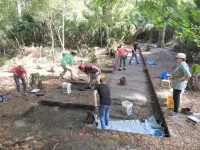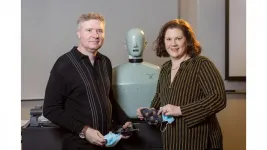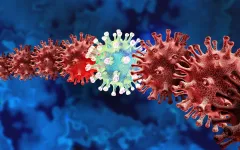Saving the climate with solar fuel
Synthetic fuels
2021-06-08
(Press-News.org) Mobility analyses show: Only a small proportion of all vehicles are responsible for the majority of the kilometers driven. We are talking above all about long-distance trucks that transport goods all over Europe. If these continue to be fueled with fossil energy, it will hardly be possible to sufficiently reduce CO2 emissions in road traffic. Synthetic fuels from surplus renewable electricity can make a significant contribution to such frequent driver applications.
With electric mobility, hydrogen mobility and synthetic fuels, Empa's future mobility demonstrator, "move", is investigating three paths for CO2 reduction in road traffic against the background of a rapidly changing energy system. "All these concepts have advantages and drawbacks in terms of energy, operation and economics. In order to use them in a smart way, we need a deeper understanding of the overall system," says Christian Bach, Head of Empa's Automotive Powertrain Technologies lab. "Together with our 'move' partners, we are working to develop knowledge that can be put into practice."
The latest project focuses on the production of synthetic methane from hydrogen and CO2 - the so-called methanization. Such fuels, produced synthetically with renewable energy - thus called synfuel or syngas -, can be transported via conventional routes and made available through the existing infrastructure. This is of interest for Switzerland as well as globally, because it opens up an enormous potential for renewable energy.
A methanization process developed at Empa
The basic chemical process of methanization has been known for over 100 years as the Sabatier reaction. In "move", another process developed further at Empa will be used: the so-called sorption-enhanced methanization. Empa researchers hope that this novel process engineering concept will lead to simpler process control, higher efficiency and better suitability for dynamic operation.
Methanization works as follows: Methane (CH4) and water (H2O) are produced by catalytic conversion from carbon dioxide (CO2) and hydrogen (H2). The water is causing problems with conventional processes, however: To remove it, serial methanization stages are typically required - with condensation areas in between. Due to the high reaction temperatures, a proportion of the water is converted back into hydrogen by the so-called water-gas shift reaction. The gaseous product of the methanization reaction thus contains a few percent hydrogen, which prevents direct feeding into the gas grid; the hydrogen must first be removed.
CO2 and water from the air
CO2 for the methanization as well as water for hydrogen production is taken directly from the atmosphere with a CO2 collector from the ETH spin-off Climeworks. The system sucks in ambient air and CO2 molecules remain attached to the filter. Using heat - around 100°C - the CO2 molecules can be released from the filter. Empa researchers see further potential for optimization in the heat required for this CO2 desorption. "Both hydrogen production and methanization continuously generate waste heat," says Bach. "By means of a clever heat management, we want to cover the heat requirements of the CO2 collector as much as possible with this waste heat". In addition to CO2, the Climeworks plant also extracts water from ambient air, which is used for hydrogen production in the electrolysis device. This means that such plants are also conceivable in regions without water supply, for example in deserts (see box).
In addition to new knowledge about technical and energetic aspects, insights about the economic efficiency of synthetic methane are one of the project's prime goals. "In order to ensure this holistic perspective, the project consortium consists of partners who cover the entire value chain - from Empa researchers to energy suppliers, filling station and fleet operators and industrial partners in the technology and plant sectors," says Brigitte Buchmann, member of Empa's Board of Directors and strategic head of "move". The project is supported by the Canton of Zurich, the ETH Board, Avenergy Suisse, Migros, Lidl Switzerland, Glattwerk, Armasuisse and Swisspower.
Currently, Christian Bach's team is concentrating on the investigation of water adsorption on porous materials and the process control of the catalytic reaction. Construction of the plant is planned for mid-2021. "About a year later, we want to refuel the first vehicle," says Buchmann. "With methane from solar energy."
Synthetic fuels from the desert?
When converting our energy system to renewable sources, there is a major challenge: Renewable sources such as sun or wind are not always available everywhere. In winter we have too little renewable energy, in summer there is too much - in the northern hemisphere. In the southern hemisphere it is the other way round. But there are also areas with almost continuous sunshine - the so-called sun belt, in which the large deserts of the Earth are located. "From a global perspective, we do not have too little renewable energy worldwide, but "merely" an energy transport problem," says Christian Bach. Synthetic energy carriers could help solve this problem.
Smaller plants in Switzerland can make a valuable contribution to the national energy system by harnessing surplus summer electricity and connecting different energy sectors. However, large plants could exploit their full potential above all in the Earth's sunbelt. This is illustrated by a simple calculation: In order to cover Switzerland's energy needs during winter not covered by hydropower as well as all long-distance domestic traffic exclusively with (imported) synthetic energy sources, a solar power plant would be required in a desert with an area of approximately 700 km2; that is 27 x 27 km or, in other words, 0.008% of the area of the Sahara. The water and CO2 needed for production could be extracted locally from the atmosphere (see main text). "Existing trade mechanisms, transport infrastructures, standards and expertise could simply be used further," says Bach. So could the plant in "move" soon be a model for a gigawatt plant in the desert?
INFORMATION:
[Attachments] See images for this press release:

ELSE PRESS RELEASES FROM THIS DATE:
2021-06-08
In a first-of-its-kind study, researchers from Tel Aviv University and the Academic College of Tel Aviv-Yaffo used smart watches and a dedicated app to monitor 169 subjects before and during Israel's second COVID-19 lockdown (October 2020). The watches and app provided the researchers with accurate daily data for measuring quality of life parameters, such as mood, stress, duration and quality of sleep, heart rate at rest, meeting others and physical exercise.
The study was conducted by a group of experts from the Iby and Aladar Fleischman Faculty of Engineering at Tel Aviv University led by Dr. Erez Shmueli, Dr. Dan Yamin, Shay Oved and Merav Mofaz, in collaboration with TAU's Prof. Noga Kronfeld Schor of the School of Zoology at the George S. Wise ...
2021-06-08
BOSTON - Last year, people who smoked had a variety of responses to the COVID-19 pandemic, with some increasing their smoking to help them cope and others quitting to potentially lessen their vulnerability to COVID-19. That's the finding of new research published in the Journal of General Internal Medicine and conducted by investigators at Massachusetts General Hospital (MGH), Vanderbilt University Medical Center and the University of Pittsburgh School of Medicine.
"Studies have shown that alcohol and opioid use increased during the pandemic, but little is known about how smokers responded," says lead author Nancy A. Rigotti, MD, director of MGH's Tobacco Research and Treatment Center and professor of Medicine at Harvard Medical School. "They might have increased ...
2021-06-08
Rising temperatures are increasingly affecting the quality of life in many regions, setting new challenges for architects, urban planners and healthcare systems. Researchers at KAUST have analyzed discomfort due to outdoor heat across Saudi Arabia and neighboring regions to help understand and combat the problem.
"Living conditions in the Kingdom have been particularly affected by the changing climate," says Hari Dasari, first author of the paper. He also emphasizes the unique challenges facing the Hajj pilgrimage visits by several million people each year. Between 2014 and 2018, the Hajj occurred in summer months when the ...
2021-06-08
UNF archaeology researchers are uncovering the lost Indigenous NE Florida settlement of Sarabay
Jacksonville, Fla. - The University of North Florida archaeology team is now fairly confident they have located the lost Indigenous northeast Florida community of Sarabay, a settlement mentioned in both French and Spanish documents dating to the 1560s but had not been discovered until now.
The type and amounts of Indigenous pottery the team is finding combined with the type and dates for European artifacts as well as cartographic map evidence strongly supports this location as the late 16th/early 17th century Mocama settlement.
The researchers have opened large excavation blocks with many exciting ...
2021-06-08
The "miracle of life" is most obvious at the very beginning: When the fertilized egg cell divides by means of furrows into blastomeres, envelops itself in an amniotic sac, and unfolds to form germ layers. When the blastomeres begin to differentiate into different cells - and when they eventually develop into a complete organism.
"We wanted to find out whether the later differences between the various cells are already partly hard-wired into the fertilized egg cell," says Dr. Jan Philipp Junker, who heads the Quantitative Developmental Biology Lab at the ...
2021-06-08
Researchers from Skoltech and Ludwig Maximilians-Universität (LMU) in Germany have studied the fundamental properties of halide perovskite nanocrystals, a promising class of optoelectronic materials. Using a combination of theory and experiment, they were able to show and explain an intricate connection between composition, light-induced lattice dynamics, and stability of the materials. The paper was published in the journal Nature Communications.
Perovskite nanocrystals (PNCs) are semiconductor nanocrystals that, thanks to their unique properties, have found a number of applications in optoelectronics, for instance, in lasers and LEDs. PNCs have a much higher photoluminescence quantum ...
2021-06-08
Accelerated cognitive decline in patients with and without existing dementia is one of the most disturbing outcomes of hospitalizations for older adults, affecting at least 2.6 million Americans every year.
But the condition, known as delirium, is believed to be preventable in up to 40 percent of hospital-acquired cases, and researchers at UC San Franciso wanted to see if simple tweaks, like avoiding nighttime interruptions to promote sleep, nixing certain prescription drugs, and promoting exercise and social engagement, could decrease its incidence.
In a June 8, 2021, study in the Journal of Hospital Medicine, the researchers followed approximately 22,700 inpatients aged 50 and ...
2021-06-08
MELVILLE, N.Y., June 8, 2021 -- As face coverings have become more and more ubiquitous during the coronavirus pandemic, their effects on nearly every aspect of life have been called into question. For one, a better understanding of the impacts of face masks and shields on acoustic transmission in classrooms could help optimize educational settings.
During the 180th Meeting of the Acoustical Society of America, which will be held virtually June 8-10, Laura and Rich Ruhala, from Kennesaw State University, will talk about how various types of face coverings may affect ...
2021-06-08
MELVILLE, N.Y., June 8, 2021 -- In a disaster, time is of the essence when searching for potential victims who may be difficult to find. Unmanned aerial vehicles make the perfect platform for state-of-the-art technology allowing emergency crews to find those in need and provide situational awareness over a large area.
During the 180th Meeting of the Acoustical Society of America, which will be held virtually June 8-10, Macarena Varela, from Fraunhofer FKIE, will describe how a system using an array of microphones and advanced processing techniques could be a lifesaver for disaster victims. The session, "Bearing Estimation of Screams Using a Volumetric Microphone Array Mounted on a UAV," will take place Tuesday, June 8, at 10:35 a.m. Eastern U.S.
During ...
2021-06-08
Variants of viruses, such as that causing COVID-19, can now be quickly studied in the laboratory, even before they emerge in nature and become a major public health challenge.
The University of Queensland, QIMR Berghofer Medical Research Institute, Peter Doherty Institute for Infection and Immunity, Monash University, and Queensland Health have developed a technology to manipulate viruses synthetically allowing rapid analysis and mapping of new potential virus variants.
UQ's lead researcher Professor Alexander Khromykh said the technology was ideal for use during a global pandemic such as COVID-19.
"This technique should give us the ability to answer questions about whether potential virus variants are susceptible to a particular drug or vaccine, even before they emerge ...
LAST 30 PRESS RELEASES:
[Press-News.org] Saving the climate with solar fuel
Synthetic fuels






